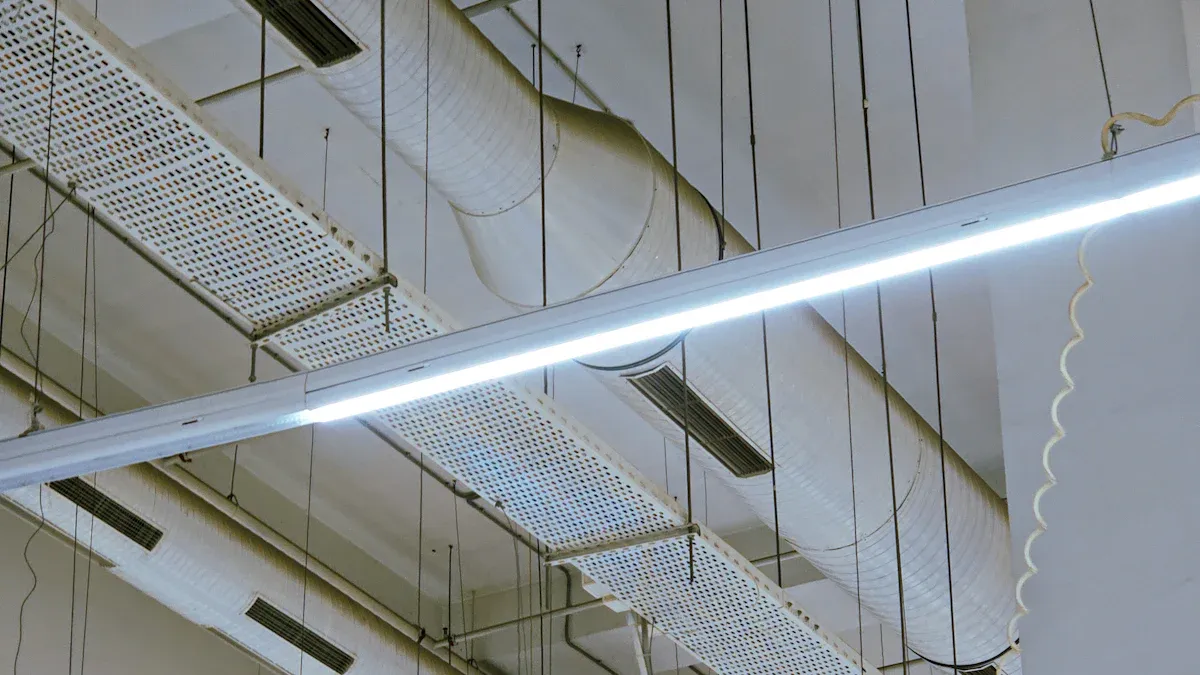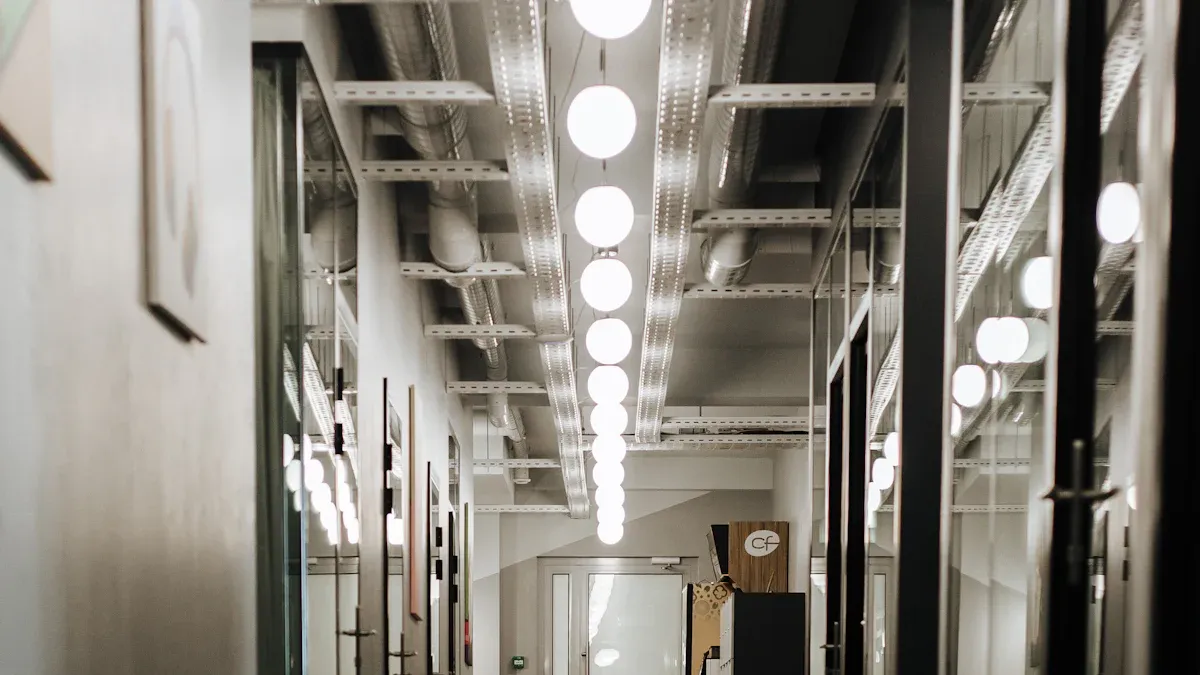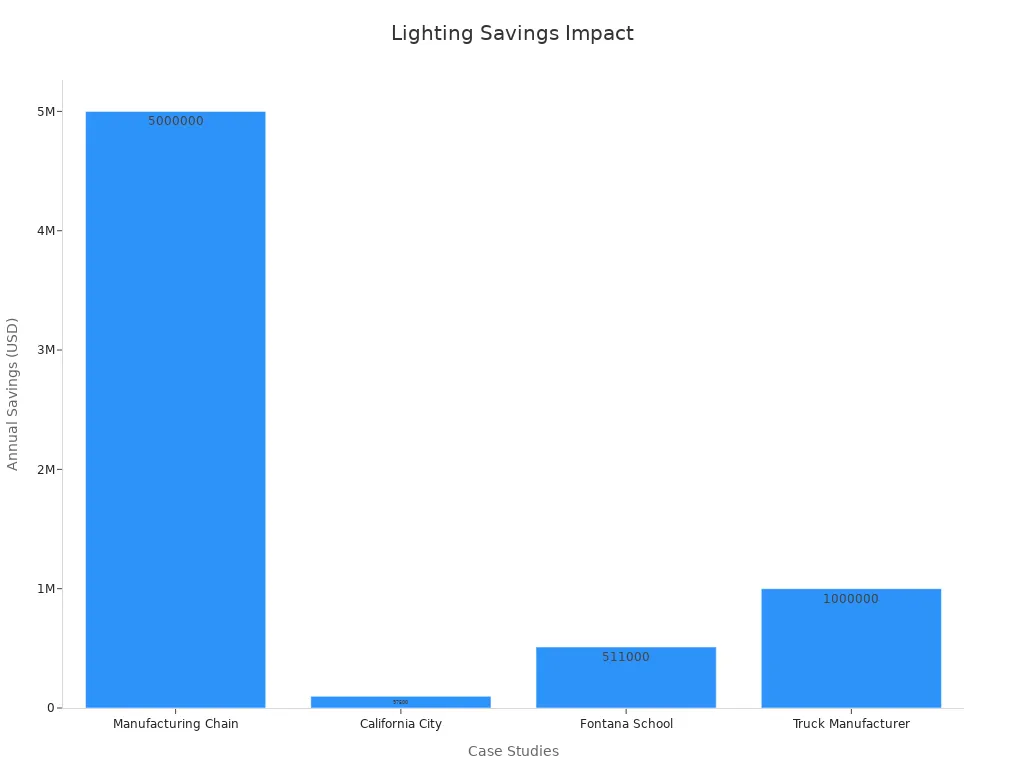Commercial Lighting: Solutions, Applications, and Best Practices for Business Environments

Lighting is very important for business spaces. It does more than look nice; it affects how workers do their jobs, how customers feel, and how safe places are. Commercial lighting helps by being both useful and energy-saving.
The worldwide commercial lighting market was worth $12.55 billion in 2023. Experts say it will grow to $21.17 billion by 2032, showing how important it is.
Good lighting, like LED lights, uses less energy—up to 70% less. This saves money on bills and lowers costs for businesses.
Bright, clear lights in offices help workers avoid eye strain. They also help people stay focused, which makes work better and faster.
Lighting also keeps people safe. Studies show bad lighting causes 25% of workplace accidents that lead to insurance claims. In stores, good lighting makes products stand out and helps customers decide what to buy.
Key Takeaways
Good lighting at work helps people stay focused. Bright lights also reduce eye strain.
Using LED lights can cut energy costs by 80%. This saves money and helps the environment.
Smart lights change brightness based on need. They save energy and make spaces comfy for workers and customers.
Keeping lights clean and checked makes them work well. Regular care ensures safety and good performance.
Picking the right lights for each area is important. Offices need bright lights, while restaurants need warm, dimmable ones.
Understanding Commercial Lighting
What Is Commercial Lighting?
Commercial lighting means lights made for business spaces. These lights are used in offices, stores, factories, and other work areas. Unlike home lights, they focus on being useful, saving energy, and lasting longer for busy places.
Many reasons explain why commercial lighting is growing. Using energy-saving LED lights is a big reason. Governments, like the US Department of Energy, push businesses to use LEDs. For example, LED lights in business spaces may grow from 219 million to 309 million by 2035. New LED designs, like brighter and more efficient ones, meet the need for eco-friendly lighting.
Rules also guide how commercial lighting works. These rules make sure lights are safe, save energy, and work well. For example, the ASHRAE/IES 90.1 standard and the International Energy Conservation Code (IECC) ask businesses to use energy-saving designs. These rules change often to keep up with new technology and better lighting ideas.
Why Is Commercial Lighting Essential for Businesses?
Commercial lighting helps make workplaces better and safer. Good lighting makes it easier to see, reduces tired eyes, and helps people focus. This makes workers more productive. In stores, smart lighting shows off products and makes the space welcoming, helping customers buy more.
Energy-saving lights, like LEDs, help businesses spend less money. For example, The Franklin Institute saved a lot by switching to LEDs. They used the extra money for things like marketing and managing inventory. This shows how good lighting can help businesses grow.
Safety is also very important. Bad lighting can cause accidents at work, costing money and causing legal problems. With enough light, businesses can lower risks and keep workers and customers safe.
Types of Commercial Lighting Solutions

Picking the right lights can change your business space. Different types of lights have special benefits, like saving energy or working better. Here are three popular choices: LED lights, smart lighting, and eco-friendly lighting.
LED Lighting
LED lights have changed how businesses light their spaces. They use 95% of energy for light and waste only 5% as heat. Compared to old bulbs, LEDs save 80-90% more energy. They also use 50-60% less energy than fluorescent lights. This helps lower bills and is better for the planet.
New LED lights give over 100 lumens per watt (lm/W). The best ones can go over 200 lm/W. Since 2010, they’ve improved by about 4 lm/W each year. By 2030, LEDs might reach 140 lm/W, helping global energy goals. These improvements make LEDs the smartest and greenest choice for businesses.
Smart Lighting Systems
Smart lighting makes business spaces smarter. These systems use sensors to know when people are around. They adjust brightness based on sunlight or user needs. This saves energy and makes spaces comfy for workers and customers.
In stores, smart lights make shopping better by showing off products. They also create a welcoming feel. Businesses using smart lights save a lot. For example, one project saved 8.5 million kWh of energy and $900,000 in costs over 4.5 years. On average, smart lights cut energy use by 20%, making them a great choice.
Sustainable Lighting Options
Being eco-friendly is important for businesses. Sustainable lights, like LEDs, help the planet and save money. Lighting uses about 15% of a home’s electricity, but LEDs can save $225 a year. For businesses, the savings are even bigger.
LEDs are up to 80% more efficient than older lights. They last longer, create less waste, and use less energy. This helps businesses meet eco-friendly goals. By choosing sustainable lights, you can reduce your carbon footprint and show you care about the environment.
Specialty Lighting
Specialty lighting is made for unique business needs. It does more than just light up spaces. It improves how places look, work, and feel. You can see specialty lighting in museums, hospitals, theaters, or fancy stores.
A big advantage of specialty lighting is setting the right mood. In museums, it lights up artifacts without harming them. In hospitals, it helps doctors see better during procedures and reduces glare. These lights make sure each place works as it should.
Specialty lighting also uses smart technology. Many systems now connect to IoT (Internet of Things). This lets businesses control brightness, colors, and light angles. These features boost work quality and make customers happy.
Here are some real-life examples of how specialty lighting changes spaces:
Case Study | Description | Quote |
|---|---|---|
The Edge | Philips lighting improves comfort and work quality. | "The Edge is now the cheapest office in the world of Deloitte." - Erik Ubels |
The Future of Offices, Toronto | Cisco uses Philips lighting with IoT benefits. | "The possibilities of this connected lighting system are endless." - Richard Lees |
Hamdan Bin Mohammed Smart University | Smart lights make learning spaces better. | "Being the first university in the world to have a smart lighting system will better equip us." - Dr. Mansoor Al Awar |
These examples show how specialty lighting changes business spaces. By using these lights, you can make places that work well and inspire people. Specialty lighting helps your business stand out and meet its goals.
Applications of Commercial Lighting

Office Spaces
Lighting in offices affects how well people work. LED lights help by reducing glare and eye strain. Studies show better lighting can boost work by 3.2% and cut headaches by 27%. This means fewer sick days and better results at work.
Good lighting also helps people focus and feel better. Lights that copy daylight can keep workers alert. Smart lights adjust brightness based on sunlight, saving energy while keeping spaces bright. Offices using these systems save money and make workers happier.
Improvement Type | Percentage/Value |
|---|---|
Increase in claims processed | 2.8% |
Avoided payroll costs | $364,000.00 |
Median improvement in productivity | 3.2% |
Reduction in headaches | 27% |
Decrease in negative moods (senior care) | 41% |
Retail Stores
In stores, lighting helps customers enjoy shopping and buy more. Bright lights make products look better and more appealing. Research shows better lighting can raise sales by 43.7% and shopper conversions by 32%.
Lighting also changes how people see your store. Warm lights feel welcoming, while cool lights look clean and modern. Smart lights can change with the time of day or season, making shopping even better.
"At Food Lion, we want checkout to be great for shoppers. In 2015, we started using LED lights at checkouts. The lights make shopping brighter and have increased sales."
Metric | Performance with Lighting | Performance without Lighting |
|---|---|---|
Dollar Sales | +43.7% | +14.0% |
Unit Sales | +37.1% | +3.1% |
Shopper Conversion | +32% | -1.4% |
Industrial Facilities
In factories, good lighting keeps workers safe and helps them work better. Bright lights make it easier to see and avoid accidents. Safety checks show fewer problems in places with better lighting.
LEDs and smart lights also save energy and give steady light. Workers feel safer and do better work with fewer mistakes. This makes the workplace more efficient and comfortable.
Evidence Type | Description |
|---|---|
Productivity Statistics | Fewer mistakes in work show better productivity. |
Safety Incident Reports | Safety checks and worker feedback show fewer accidents with better lighting. |
Qualitative Feedback | Workers feel safer and more comfortable with good lighting. |
By using advanced lighting, factories can be safer, more efficient, and save on energy costs.
Hospitality and Restaurants
Lighting helps make restaurants and hotels more enjoyable for guests. The right lighting can change how a place feels and looks.
Soft, warm lights make spaces calm and welcoming, perfect for dining or lobbies.
Bright, cool lights give energy, great for gyms or meeting rooms.
Lights that can be adjusted let staff change the mood during the day.
Guests like controlling room lights. It helps them work or relax better.
Using different types of lights together makes spaces feel cozy and balanced.
These ideas can make guests happier and your business stand out. Good lighting isn’t just pretty—it also makes spaces work better and feel more comfortable. Guests will remember the great experience.
Outdoor and Parking Lot Lighting
Outdoor lights are important for keeping people safe. A bright parking lot helps stop accidents and protects businesses from lawsuits.
“Owners must keep parking lots safe. If someone gets hurt, they could face legal trouble.” – Attorney William Turner
Putting LED lights in the right spots can stop crimes and make areas safer. Communities with good lighting see big improvements.
A study by the Campbell Collaboration found crime dropped by 21% with better parking lot lights.
Bright, energy-saving lights help drivers and walkers see clearly. This lowers risks and makes places more welcoming.
“Smartly placed LED lights can cut crime, prevent accidents, and make areas safer for everyone.”
Outdoor lights do more than protect—they build trust. When people feel safe, they come back, making it a smart choice for your business.
Best Practices for Commercial Lighting
Checking Your Lighting Needs
Before changing your lights, check what your space needs. Look at how each area is used. Offices need bright lights to help people work better. Stores need lights that show off products and feel welcoming.
Think about how bright the lights are, their color, and where they go. Studies show good lighting helps spaces work better and look nicer. For example, lights that copy daylight help people stay alert and think clearly. These are great for workplaces.
Also, check how much energy your lights use. Find ways to save energy. Smart tools like daylight sensors can stop wasting power. By checking your needs, you can pick lights that match your goals and improve your space.
Planning for Energy Savings
Saving energy with lights helps cut costs and protect the planet. LED lights are a great choice. They use 75% less energy than old bulbs and last longer. Businesses using LEDs can cut energy use by up to 80%.
Saving energy isn’t just about picking the right bulbs. Use smart systems too. These systems change brightness based on sunlight or if people are in the room. One office saved 35% on energy bills by using LED lights. This shows how saving energy also saves money.
By focusing on energy savings, you spend less and help the environment. This makes your business modern and ready for the future.
Picking the Best Lights for Each Area
Different spaces need different kinds of lights. Offices need bright lights that don’t hurt your eyes. Restaurants do better with warm lights that feel cozy and can change.
Custom lighting can make spaces work better and look nicer. One study showed how special lights saved energy and made spaces more fun for customers. Lights that change for tasks or times of day also save money and improve customer experiences.
When choosing lights, think about brightness, color, and where they go. New lights like OLEDs are flexible and save energy. They work well for many business needs. Picking the right lights makes spaces useful and nice to look at.
Regular Maintenance and Upgrades
Taking care of your lighting system often helps it work well and last longer. Over time, dust and dirt can build up on lights, making them dimmer and less efficient. Cleaning and checking your lights regularly can stop these problems and keep your space bright.
Here are some simple maintenance tips:
Wipe lights and covers to remove dust and dirt.
Check wires and connections for damage or wear.
Fix broken parts quickly to avoid bigger problems.
Change multiple bulbs at once to keep lighting even.
Regular care also keeps LEDs working their best. While LEDs save energy, they can lose brightness if not cleaned. Cleaning them often ensures they stay bright and cost-effective. For example, changing all bulbs together saves money and keeps lighting consistent.
Upgrading your lights is just as important. New tech, like smart lights and better LEDs, uses less energy and works better. Upgrades lower energy use and make your business look nicer. Combining regular care with upgrades keeps your lights modern and dependable.
Tip: Write down cleaning, repairs, and upgrades in a log. This helps you stay organized and not miss any tasks.
Ensuring Compliance with Standards
Following lighting rules is important for safety, saving energy, and meeting laws. These rules make sure your lights are safe, efficient, and work well. Checking your system often helps you follow the rules and avoid fines.
Here’s what to check for compliance:
Goal | What It Means |
|---|---|
Energy use check | Measures how much energy your lights use. |
Light quality review | Checks how good the light looks and feels. |
Maintenance check | Looks at how well you care for your lights. |
Safety check | Makes sure your lights meet safety rules. |
Technology review | Checks if your lights use the latest, most efficient tech. |
Cost check | Reviews if your lighting system is saving money. |
Getting certified proves your lights meet industry standards. Tests check things like brightness, energy use, and safety. This shows your system is high-quality and builds trust with customers.
Note: Stay updated on new rules to keep your lights safe and efficient. Ask experts to help you meet all requirements.
Good lighting is key to business success. It helps workers do better, keeps places safe, and makes customers feel welcome. Using energy-saving lights like LEDs or smart systems cuts costs and helps the planet. Well-planned designs make spaces work well, and regular care keeps lights working great.
Here are some real-life examples of lighting upgrades:
Example/Case Study | Yearly Savings | Details |
|---|---|---|
Factory Chain | Saved energy costs with better lights and solar power. | |
City in California | $97,500 | Cut energy bills while keeping buildings safe and healthy. |
Fontana School | $511,000 | Saved money by using energy more wisely. |
Truck Company | $1 million | Expected savings with low-carbon lighting technology. |

Check your current lights to find ways to improve. Upgrading to new systems can save money, make spaces better, and help the environment.
FAQ
What are the benefits of switching to LED lighting for businesses?
LED lights save up to 80% energy and last longer. They need less fixing, give better light, and cut carbon emissions. These features make LEDs a smart and eco-friendly choice for businesses.
How can smart lighting systems improve energy efficiency?
Smart lights use sensors to save energy. Motion sensors turn off lights in empty rooms. Daylight sensors dim lights when sunlight is enough. These systems lower energy use and cut bills.
Are there any government incentives for upgrading to energy-efficient lighting?
Yes, many governments offer rebates or grants for using LEDs. Check local programs or ask experts about these incentives. They help lower the cost of switching to better lighting.
How often should commercial lighting systems be maintained?
Check your lights every 6-12 months. Clean them to remove dust and check wires for damage. Replace flickering bulbs to keep lights working well and safe for everyone.
What is the best way to choose lighting for different business areas?
Think about what each space needs. Offices need bright lights for work. Stores do better with warm lights to show products. Restaurants need lights that can change to set the mood. Picking the right lights makes spaces work and look better.
See Also
Exploring LED Area Lights: Uses, Advantages, and Setup Tips
Essential Insights on LED Area Lights: Varieties and Setup
Choosing Industrial LED Bulbs: Performance, Uses, and Options
Evaluating Commercial LED Bulbs: Expenses and Business Returns

